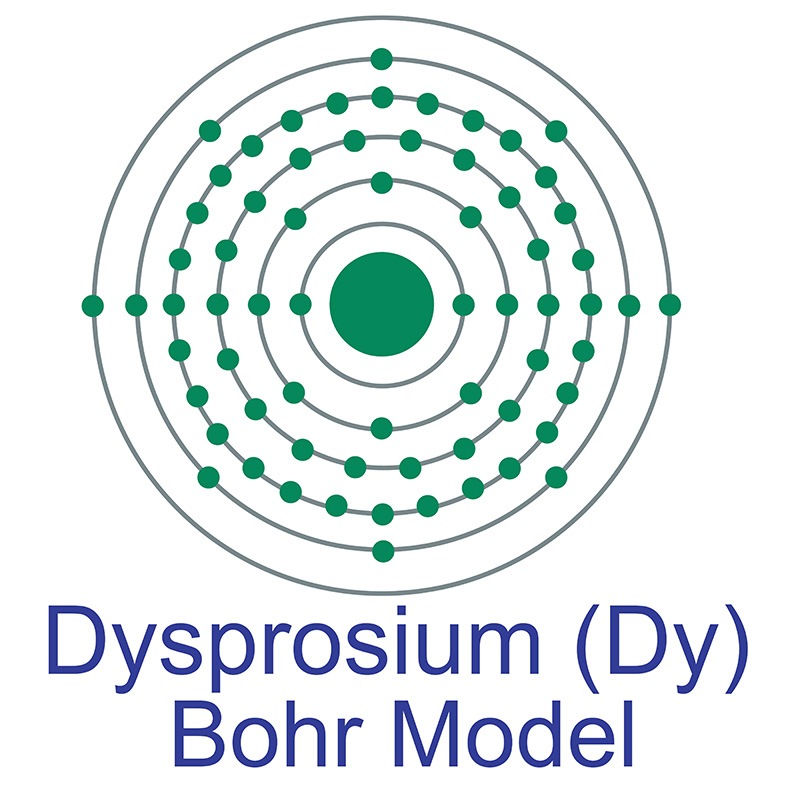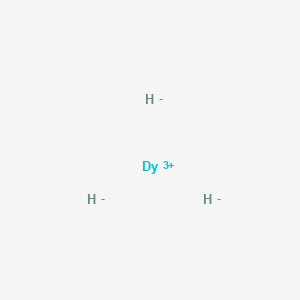SECTION 1. IDENTIFICATION
Product Name: Dysprosium Hydride
Product Number: All applicable American Elements product codes, e.g. DY-HID-02
, DY-HID-03
, DY-HID-04
, DY-HID-05
CAS #: 13537-09-2
Relevant identified uses of the substance: Scientific research and development
Supplier details:
American Elements
10884 Weyburn Ave.
Los Angeles, CA 90024
Tel: +1 310-208-0551
Fax: +1 310-208-0351
Emergency telephone number:
Domestic, North America: +1 800-424-9300
International: +1 703-527-3887
SECTION 2. HAZARDS IDENTIFICATION
Signal Word: Danger
Hazard Statements
H228 Flammable solid.
H261 In contact with water releases flammable gas.
H302+H312+H332 Harmful if swallowed, in contact with skin, or if inhaled. H315 Causes skin irritation.
H319 Causes serious eye irritation.
H335 May cause respiratory irritation.


Precautionary Phrases
P210 Keep away from heat/sparks/open flames/hot surfaces.
P223 Keep away from any possible contact with water, because of violent reaction and possible flash fire.
P231+P232 Handle under inert gas. Protect from moisture.
P240 Ground/bond container and receiving equipment.
P241 Use explosion-proof electrical/ventilating/lighting equipment.
P261 Avoid breathing dust/fume/gas/mist/vapors/spray.
P280 Wear protective gloves/protective clothing/eye protection/face protection.
P301+P312 IF SWALLOWED: Call a POISON CENTER or doctor/physician if you feel unwell. P302+P352 IF ON SKIN: Wash with plenty of soap and water.
P304+P340 IF INHALED: Remove victim to fresh air and keep at rest in a position comfortable for breathing.
P305+P351+P338 IF IN EYES: Rinse cautiously with water for several minutes. Remove contact lenses if present and easy to do. Continue rinsing.
HMIS CLASSIFICATION:
Health: 1
Fire: 2
Reactivity Hazard: 2
NFPA RATING:
Health: 1
Flammability: 2
Reactivity Hazard: 2
EYE CONTACT: Causes serious eye irritation.
SKIN CONTACT: Causes skin irritation.
INHALATION: May cause respiratory irritation.
INGESTION: Harmful if swallowed.
SECTION 3. COMPOSITION/INFORMATION ON INGREDIENTS
Formula: DyH3
Cas number: 13537-09-2
Molecular weight: 165.52382
SECTION 4. FIRST AID MEASURES
EYE EXPOSURE: Immediately flush the eyes with copious amounts of water for at least 15 minutes. Assure flushing under eyelids. A victim may need assistance in keeping their eyelids open. Get immediate competent medical attention.
SKIN EXPOSURE: Wash affected area with water. Remove contaminated clothes if necessary. Seek medical assistance if irritation persists.
INHALATION: Remove to fresh air and keep at rest. If breathing is difficult, give oxygen. If not breathing, give artificial respiration. Get medical attention.
INGESTION: Seek medical attention immediately.
SECTION 5. FIREFIGHTING MEASURES
FLASH POINT: Flammable solid.
Autoignition: Not available
EXPLOSION LIMITS: Not available
EXTINGUISHING MEDIUM: Carbon dioxide, dry chemical powder, or alcohol resistant foam. DO NOT USE WATER!
SPECIAL FIRE FIGHTING PROCEDURES: Wear self-contained, approved breathing apparatus and full protective clothing, including eye protection and boots. Contact with water releases flammable gases.
HAZARDOUS COMBUSTION AND DECOMPOSITION PRODUCTS: Hydrogen, fumes of nitrogen oxides.
SECTION 6. ACCIDENTAL RELEASE MEASURES
PERSONAL PRECAUTIONS: Wear all appropriate equipment when using this material. Ensure adequate ventilation. Avoid the formation of dust. Avoid breathing vapors, mist, gas, or dust. ENVIRONMENTAL PRECAUTIONS: Prevent spillage from entering drains or allowing to be released into the environment.
METHODS AND MATERIALS FOR CONTAINMENT AND CLEANING UP: Shut off all sources of ignition. Contain spill with inert material. Pick up and arrange disposal without creating dust. Ventilate and wash spill site after material is pickup is complete. Sweep up and keep in suitable, closed containers for disposal. Dispose of all waste and cleanup materials in accordance with regulations.
SECTION 7. HANDLING AND STORAGE
PRECAUTIONS FOR SAFE HANDLING: Wear appropriate personal protective equipment. Avoid contact with skin and eyes. Use with adequate ventilation. Avoid formation of dusts and aerosols. Handle under inert gas. Keep away from sources of ignition.
CONDITIONS FOR SAFE STORAGE: Store in cool, dry well ventilated area. Keep away from incompatible materials. Store under nitrogen or argon. Protect from moisture, acids, and oxidizers.
SECTION 8. EXPOSURE CONTROLS/PERSONAL PROTECTION
EXPOSURE CONTROLS: Contains no substances with occupational exposure limit values.
EYE PROTECTION: Wear chemical safety glasses or goggles and face shield.
SKIN PROTECTION: Wear nitrile or rubber gloves, and a complete suit protecting against chemicals. VENTILATION: Provide local exhaust, preferably mechanical.
RESPIRATOR: Use an approved respirator.
ADDITIONAL PROTECTION: Provide eyewash stations, quick-drench showers and washing facilities accessible to areas of use and handling.
SECTION 9. PHYSICAL AND CHEMICAL PROPERTIES
FORM: powder
MOLECULAR WEIGHT: 165.52382
BOILING POINT: No data available
MELTING POINT: No data available
DENSITY: 7.1 g/cm3
SECTION 10. STABILITY AND REACTIVITY
STABILITY: Stable
HAZARDOUS POLYMERIZATION: Will not occur
CONDITIONS TO AVOID: Humidity, all sources of ignition
INCOMPATIBILITY: Oxidizing agents, alcohols, water, acids, moisture, fluorine, chlorine, bromine, iodine, carbon tetrachloride, freons, and halogens.
DECOMPOSITION PRODUCTS: Hydrogen, fumes of nitrogen oxides.
SECTION 11. TOXICOLOGICAL INFORMATION
STABILITY: Stable
HAZARDOUS POLYMERIZATION: Will not occur
CONDITIONS TO AVOID: Humidity, all sources of ignition
INCOMPATIBILITY: Oxidizing agents, alcohols, water, acids, moisture, fluorine, chlorine, bromine, iodine, carbon tetrachloride, freons, and halogens.
DECOMPOSITION PRODUCTS: Hydrogen, fumes of nitrogen oxides.
To the best of our knowledge the toxicological effects of this compound have not been fully investigated.
SECTION 12. ECOLOGICAL INFORMATION
No data available
SECTION 13. DISPOSAL CONSIDERATIONS
Dispose of in according to local, state, and federal regulations.
SECTION 14. TRANSPORT INFORMATION
UN3132 Marine Pollutant: No
Water-reactive Solid, Flammable, n.o.s. CLASS 4.3 (4.1) Packing Group: II
SECTION 15. REGULATORY INFORMATION
TSCA: Listed in the TSCA inventory
SARA 302/304: Not Listed SARA 311/312: Not Listed SARA (TITLE 313): Not Listed CALIFORNIA PROP. 65: Not Listed
MASSACHUSETTS RIGHT TO KNOW COMPONENTS: No components are subject to the Massachusetts Right to Know Act. NEW JERSEY RIGHT TO KNOW COMPONENTS: No components are subject to the New Jersey Right to Know Act. PENNSYLVANIA RIGHT TO KNOW COMPONENTS: No components are subject to the Pennsylvania Right to Know Act.
SECTION 16. OTHER INFORMATION
Safety Data Sheet according to Regulation (EC) No. 1907/2006 (REACH). The above information is believed to be correct but does not purport to be all inclusive and shall be used only as a guide. The information in this document is based on the present state of our knowledge and is applicable to the product with regard to appropriate safety precautions. It does not represent any guarantee of the properties of the product. American Elements shall not be held liable for any damage resulting from handling or from contact with the above product. See reverse side of invoice or packing slip for additional terms and conditions of sale. COPYRIGHT 1997-2022 AMERICAN ELEMENTS. LICENSED GRANTED TO MAKE UNLIMITED PAPER COPIES FOR INTERNAL USE ONLY.

 The number of electrons in each of dysprosium's shells is [2, 8, 18, 28, 8, 2] and its electron configuration is [Xe]4f10 6s2. The dysprosium atom has an atomic radius of 178 pm and a Van der Waals radius of 229 pm. Dysprosium was first discovered by Paul Emile Lecoq de Boisbaudran in 1886. In its elemental form, dysprosium has a silvery-white appearance.
The number of electrons in each of dysprosium's shells is [2, 8, 18, 28, 8, 2] and its electron configuration is [Xe]4f10 6s2. The dysprosium atom has an atomic radius of 178 pm and a Van der Waals radius of 229 pm. Dysprosium was first discovered by Paul Emile Lecoq de Boisbaudran in 1886. In its elemental form, dysprosium has a silvery-white appearance.  It is a member of the lanthanide or
It is a member of the lanthanide or 
